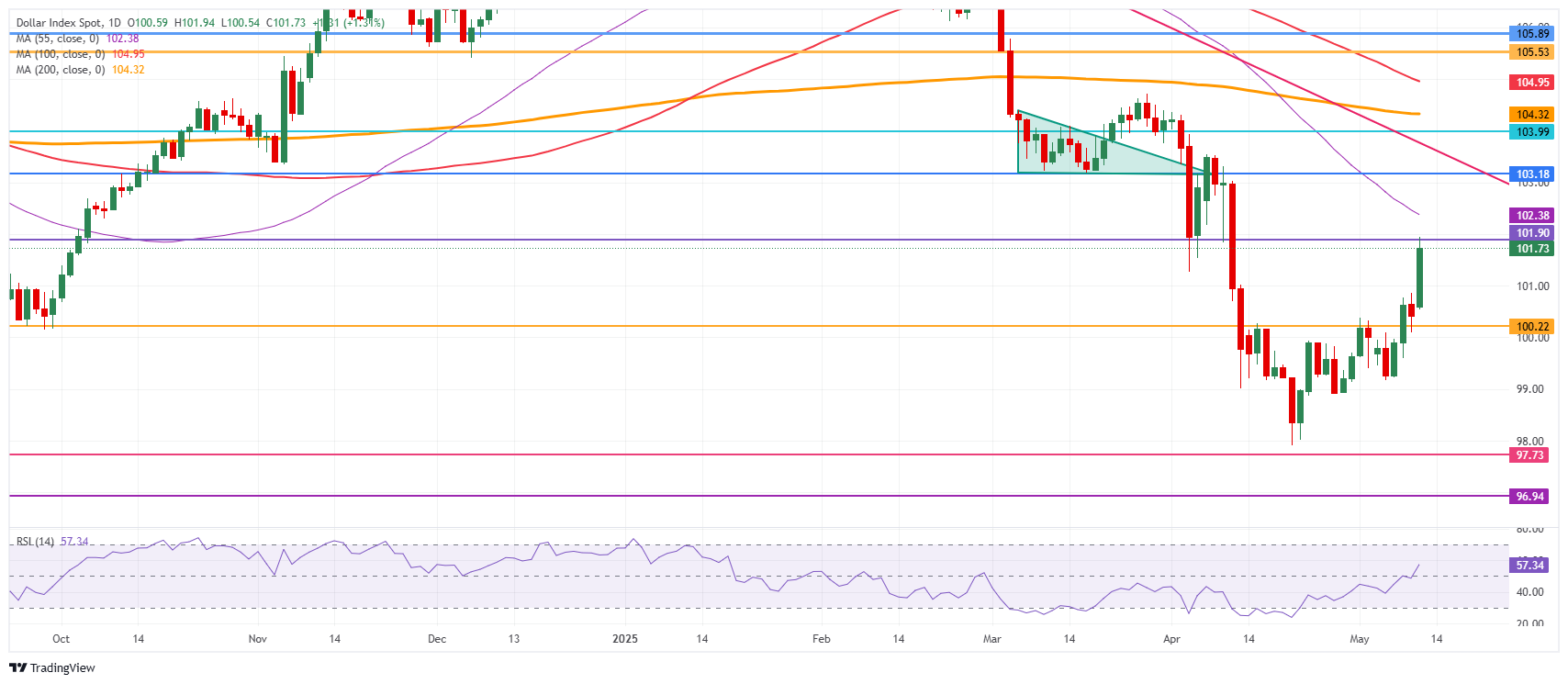US Dollar soars to one-month high on US-China deal to temporarily lower tariffs
- The US Dollar rolls through markets, up over 1% against most major peers, after news of a deal between China and the US.
- The euphoria comes after both countries agree to slash tariffs for 90 days following two days of talks in Switzerland.
- The US Dollar Index pops to 101.50, benefiting from the relief in US-China tensions.
The US Dollar Index (DXY), which tracks the performance of the US Dollar (USD) against six major currencies, jumps more than 1% on Monday after China and the United States (US) agreed to a 90-day pause in their trade war by slashing tariffs on both sides. After a weekend of discussion, US Treasury Secretary Scott Bessent announced the defusing of the trade war between the two nations: China will lower its tariffs on US goods to only 10% from the original 125%, while the US will do so to 30% (from 145%) on Chinese goods, both for 90 days, Bloomberg reports. The news sent the US Dollar to its highest level in one month.
Several correlations are kicking in again on the back of this event, with the benchmark 10-year US Treasury yield hitting 4.45%. The rate differential gap between the US and other countries sees the Greenback being valued higher against the local currencies of countries with lower yields. The repercussion of this correlation could be that Federal Reserve rate cuts for 2025 get fully priced out.
Daily digest market movers: Agenda to be ignored due to trade deal
- US Treasury Secretary Scott Bessent announced during a press conference in Switzerland the breakthrough between the US-China trade war has led to a pause of 90 days and the lowered reciprocal tariffs for both parties. Bessent went on by saying that both countries want to defuse the situation and said that a possibility of a China purchasing agreement could be possible, Bloomberg reports.
- At 14:25 GMT, Federal Reserve Bank Governor Adriana Kugler delivers a speech on the economic outlook at the National Association for Business Economics and the Central Bank of Ireland's International Economic Symposium, in Dublin, Ireland.
- Around 18:00 GMT, the Loan Officer Survey (SLOOS) for the first quarter is due. The report often tells more about the lending circumstances in the US for households and small businesses.
- Equities see the US futures outshine all other indices. European equities are up by roughly 1.50%, while US futures are seeing between 3% to even 4% gains.
- The CME FedWatch tool shows the chance of an interest rate cut by the Federal Reserve in June’s meeting at just 7.9%. Further ahead, the July 30 decision sees odds for rates being lower than current levels at 44.1%.
- The US 10-year yields trade around 4.45%, edging higher towards levels not seen since the beginning of April, and reducing rate cut bets for 2025.
US Dollar Index Technical Analysis: Stage 1 completed
Bulls are returning to support the US Dollar Index (DXY), and they are leaving an impressive mark. The DXY pops over 1% higher and is nearing that pivotal 101.90 level that could unlock a return back to the moving averages. It will depend on whether the beginning of the US session causes a second wave of US Dollar buying.
On the upside, the DXY’s first resistance comes in at 101.90, which acted as a pivotal level throughout December 2023 and as a base for the inverted head-and-shoulders (H&S) formation during the summer of 2024. In case Dollar bulls push the DXY even higher, the 55-day Simple Moving Average (SMA) at 102.37 comes into play.
On the other hand, the previous resistance at 100.22 is now acting as firm support, although the 97.73 support could also be tested on any substantial bearish headline. Further below, a relatively thin technical support comes in at 96.94 before looking at the lower levels of this new price range. These would be at 95.25 and 94.56, meaning fresh lows not seen since 2022.

US Dollar Index: Daily Chart
US-China Trade War FAQs
Generally speaking, a trade war is an economic conflict between two or more countries due to extreme protectionism on one end. It implies the creation of trade barriers, such as tariffs, which result in counter-barriers, escalating import costs, and hence the cost of living.
An economic conflict between the United States (US) and China began early in 2018, when President Donald Trump set trade barriers on China, claiming unfair commercial practices and intellectual property theft from the Asian giant. China took retaliatory action, imposing tariffs on multiple US goods, such as automobiles and soybeans. Tensions escalated until the two countries signed the US-China Phase One trade deal in January 2020. The agreement required structural reforms and other changes to China’s economic and trade regime and pretended to restore stability and trust between the two nations. However, the Coronavirus pandemic took the focus out of the conflict. Yet, it is worth mentioning that President Joe Biden, who took office after Trump, kept tariffs in place and even added some additional levies.
The return of Donald Trump to the White House as the 47th US President has sparked a fresh wave of tensions between the two countries. During the 2024 election campaign, Trump pledged to impose 60% tariffs on China once he returned to office, which he did on January 20, 2025. With Trump back, the US-China trade war is meant to resume where it was left, with tit-for-tat policies affecting the global economic landscape amid disruptions in global supply chains, resulting in a reduction in spending, particularly investment, and directly feeding into the Consumer Price Index inflation.

